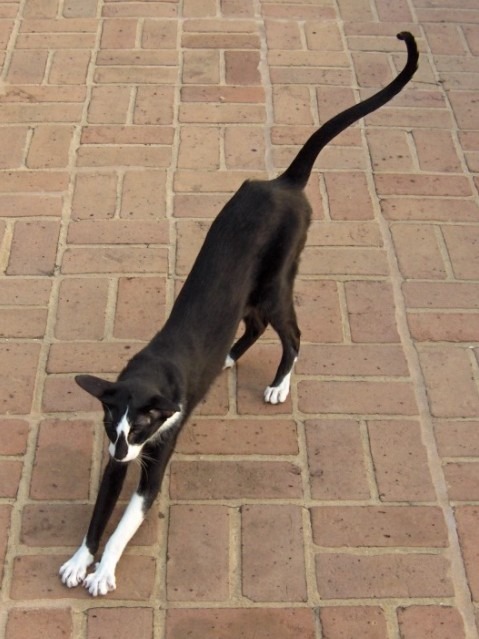A new and notable member of the cat fancy, the Oriental cat is a slender, sophisticated feline, with large, conspicuous ears, almond-shaped eyes, and a coat available in up to 300 color combinations. This cat boasts high intelligence, athleticism, and a relatively vocal personality as a part of the Siamese family. But while its roots trace much to Thailand, the Oriental cat prized by many feline enthusiasts today has been more freshly and uniquely developed in the United States.
Origin of the Oriental Cat
After World War II, many domestic cat breeds were put to the brink of extinction. Many breeders crammed to restore many members of the cat fancy, including the renowned Siamese. In line with that, English breeders started incorporating the Abyssinian, Russian Blues, and British Shorthair into their gene pool.
Non-pointed kittens became the products of the said programs, which were crossed again to Siamese cats. The succeeding attempts produced Siamese-resembling kittens, and also other non-pointed but distinct and stunning combinations.
Initially, every non-pointed resulting coat was assigned its own name. However, it would be impractical to do so, given that there is an incredibly long list of patterns and combinations available. A consensus was made, designating all the non-pointed kittens as Orientals.
Physical Characteristics of the Oriental Cat
Length: 12 to 15 inches
Weight: 7 to 10 pounds (Males), 5 to 8 pounds (Females)
Life Expectancy: 10 to 15 years
Coat Color: White, ebony, blue, red, cream, frost, platinum, chestnut, cinnamon, champagne, seal, chocolate, and lavender
Type of Coat: Short or Longhair
Eye Color: Greeb, Blue, Odd-eyed
Oriental cats are slender, striking felines, characterized by a medium-sized, nicely muscled build. Its head is a long triangle, with the tall ears serving as a continuation of the triangular shape. The neck, nose, and tail are also long. Eyes are almond-shaped, usually of a bright green tone but can also be blue or odd-eyed. Their coat can either be short or long, with the former being short or close to the body, while the latter has mid-length fur.
Oriental Shorthair Cat Personality
Bearing a Siamese lineage, the Oriental is also a chatty and opinionated feline. These felines will never hesitate to convey what they are thinking, usually in a loud, scratchy voice. They are demanding and would not like it if you fail to pay attention and meet their request.
Nevertheless, Oriental cats are passionate and kind-hearted to their families, building strong bonds with them, and devoting themselves in lifetime companionship. However, owners must be ready for their vocal side. These cats can talk all day and may shock those who are not fond of having a talkative buddy.
Highly social, these cats will follow their masters around the house, observe every action, and direct any move. When their favorite persons are sitting, the Oriental will nag to stay in their lap. They also become bossy at night, sleeping in their owners’ bed, with their head on the pillow, while cozily snoozing under the cover.
Oriental cats are also agile and athletic. They love to play and will be happiest playing with puzzle toys with their owners, chasing teaser toys, or climbing high points in the house. But, they are also blessed with smarts and combine that with their vigor, these cats are unsurprisingly capable of opening cabinets or doors and sifting across many parts of the house looking for something fun to play with.
Caring for the Oriental Cat
Sporting a smooth, shiny coat that lies close to their body, the Oriental cats are a low-maintenance breed. In fact, these fur balls do pretty in grooming themselves. Of course, they surely enjoy any attention and will appreciate weekly brushing to remove dirt, debris, and loose hair, keeping their fur in its tip-top condition.
Oriental cats are generally healthy, but regular vet consultations, immunizations, and parasite control are recommended as with other cat breeds. Due to their Siamese ancestry, Oriental cats are predisposed to the same conditions as their compatriots. Some diseases to watch out for include dilated cardiomyopathy, bladder stones, and liver amyloidosis.
Obesity can also be an issue, but it’s a great thing that obese Oriental cats can be spotted pretty easily. These felines quickly develop a potbelly after munching extra food even just for a day. It is very essential to be keen on their nutrition, as having a fat build may not do good on their long, slender legs.
Luckily, Oriental cats are an athletic breed. These felines are active, playful, and have an innate love for climbing and jumping, serving as their exercise to keep them in shape. High perches and cat trees are suitable investments to add in the house not only to fulfill their pleasure but to keep their body running.
When it comes to toddlers, Oriental cats are very much welcome to have them around as playmates. Yet, it is best to teach kids how to respect and handle these felines with care. As long as children play with them gently, they can be great friends, providing the family with extended hours of fun throughout the day.
Oriental cats are purr-fect for owners who have ample time to spend interacting with their chosen feline. These cats are loyal, devoted, vocal, and affectionate, but may dwindle if not given adequate attention. If brought to the right home, these fur balls promise years of fun and affection to their loving families.

